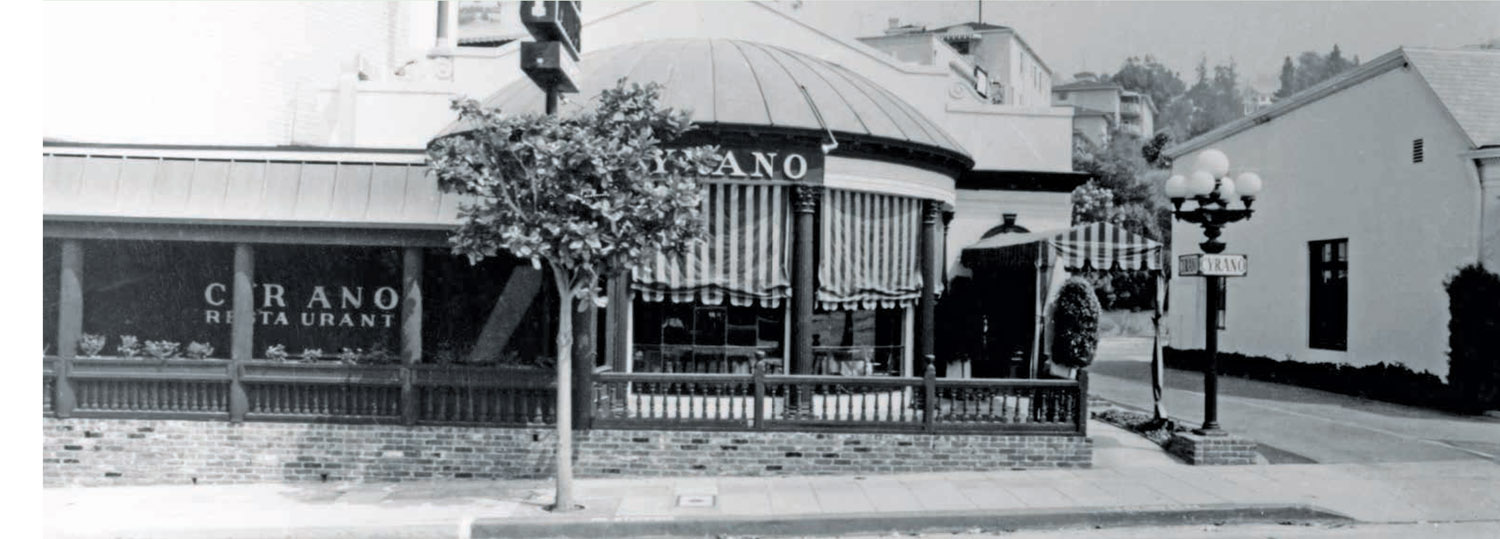OPEN: 1958–1985
LOCATION: 8711 Sunset Boulevard West Hollywood, CA 90069
ORIGINAL PHONE: OL 5-9836
CUISINE: American
BUILDING STYLE: Renaissance Storefront
CURRENTLY: Diva Rocker Glam

BEFORE CYRANO OPENED ON THE SUNSET STRIP IN 1958, THE BUILDING AT 8711 SUNSET BOULEVARD HAD SEEN ITS SHARE OF CONTROVERSY. In 1942, during World War II, the U.S. government listed thirty bars, clubs, and restaurants that our men in uniform were not allowed to frequent. Café Internationale, as it was called then, was one of them.
“These taverns and bars are not safe or proper places for servicemen to patronize,” a naval commander told the L.A. Times. “Firm handling is necessary to eliminate that undesirable fringe of the industry.”
The precise nature of the “unsafe” and “improper” activities at these nightspots was left unstated, but Café Internationale was known to feature cross-dressing performers. As a result of the military ban, the Department of Alcoholic Beverage Control revoked the café’s liquor license. In 1942, the owner, Elmer Wheeler, sued to have the license reinstated, but he passed away the following December and the club closed for good.
Cyrano breathed life into the building again in 1958, when it opened as a small coffee and sandwich shop. Bob Fidler, a young millionaire stock trader, could see from his office window across the street that the little place had potential. He bought the café and gave it a new look and attitude. He wanted it to be equally inviting for everyone, whether they were dressed up or in jeans and a T-shirt. This was a new concept on the Strip, where restaurants and clubs usually catered to clean-cut, well-dressed customers.
The restaurant faced Sunset Boulevard, with inviting bow windows and tables surrounding a fireplace. On warm days and summer evenings, diners sat outside on the patio, people-watching beneath tall trees and hanging ferns.
Fidler knew quality food and cared deeply about where the Cyrano ingredients came from. At one point, he raised his own cattle for the restaurant’s beef. The lunch and dinner menus at Cyrano featured veal, steak, and escargots, as well as what reviewers called one of the best-tasting garlic breads in the city. Saturday’s soup of the day was always cold vichyssoise. The most popular time to eat at the restaurant was late at night, if you could get a table. On weekends, the kitchen was open until 3:00 AM, so revelers could drop in after the clubs closed. After-dinner fare was lighter, with an offering of crepes, omelets, and cappuccinos.
Young stars like Sal Mineo, Troy Donahue, Suzanne Pleshette, and Natalie Wood started to gravitate to the late-night spot. Music greats such as Elton John, Rod Stewart, Neil Diamond, and Elvis Presley came in after playing gigs at Gazzarri’s, Pandora’s Box, and the Troubadour.
Staying true to his “come one, come all” mentality, Fidler installed motorcycle parking spaces right in front of the restaurant to cater to the “rough” crowd. Fidler also kept “house accounts” for his regulars, and simply invoiced them at the end of every month. This system made things much easier for all parties involved, and also resulted in higher sales, since no one noticed how much they were spending.
In 1968, the Los Angeles Times declared that the Sunset Strip restaurants were dying, having been choked off by the music scene and higher-end diners. Fidler, who had become president of the Sunset Strip Restaurant Association, responded that there were twenty-six establishments within a two-mile stretch on the Strip that brought in over $20 million in business. The real issue, he argued, was that parking on Sunset caused traffic problems. This issue was settled with a new rule: no parking on the Strip after 8:00 PM.
Just as he had spotted the little place across the street from his office and knew it could be a winner, Fidler continued to recognize good concepts and moneymaking ideas in the restaurant industry. In his later years, he was one of the prime investors in California Pizza Kitchen and Baja Fresh. Fidler went on to open more Cyrano locations in beachside cities. 
![]()

Outside Cyrano, 1965.